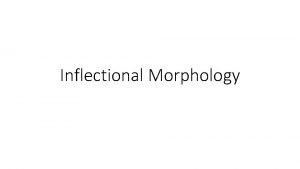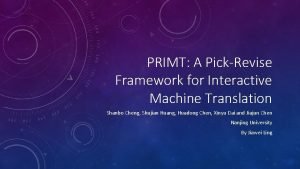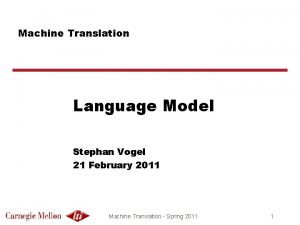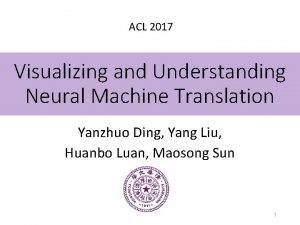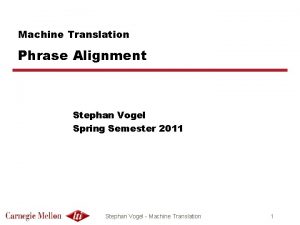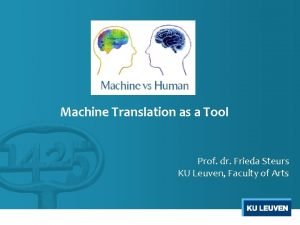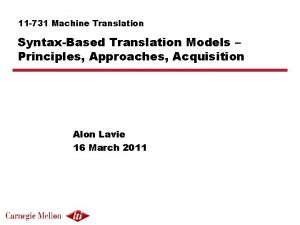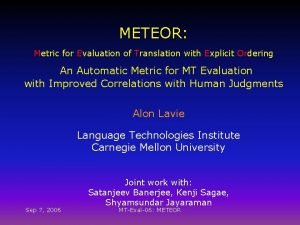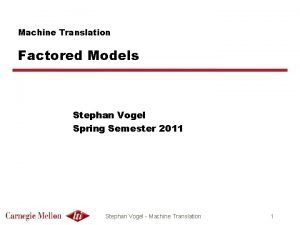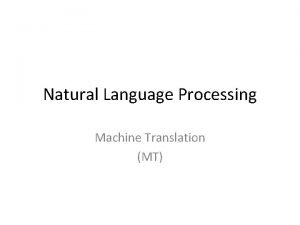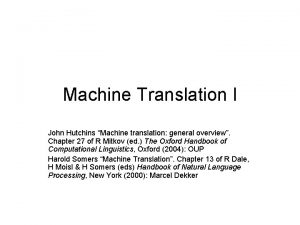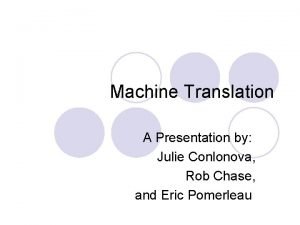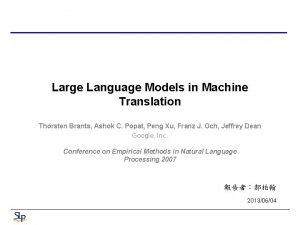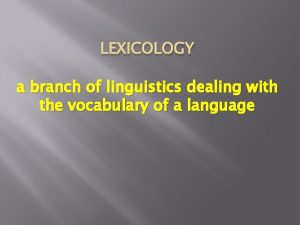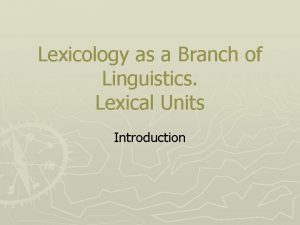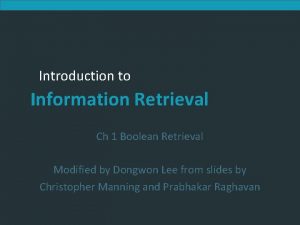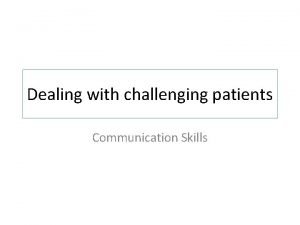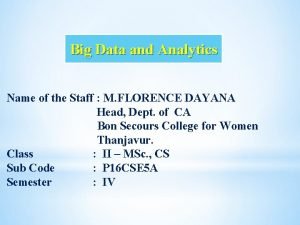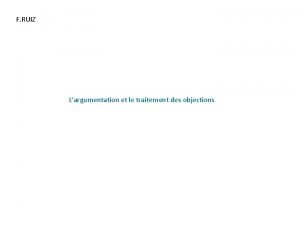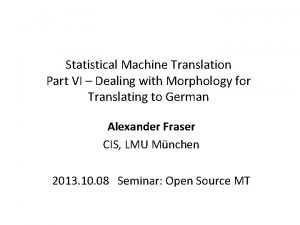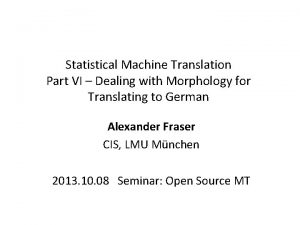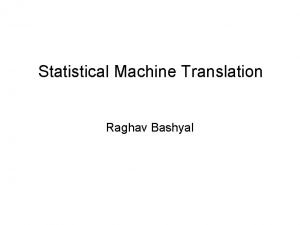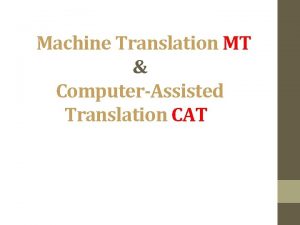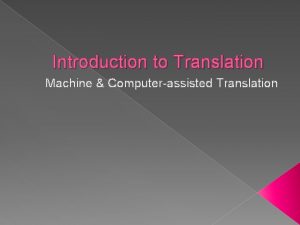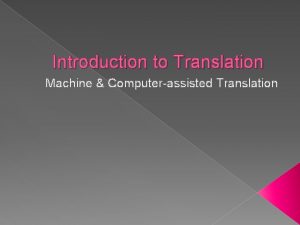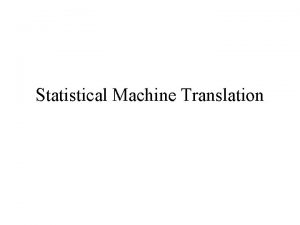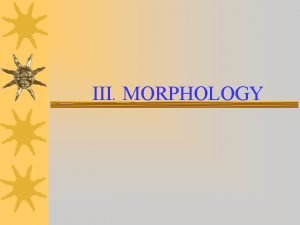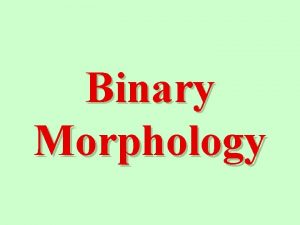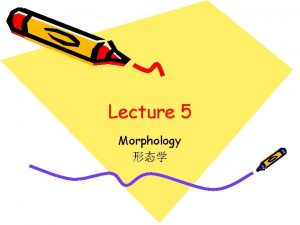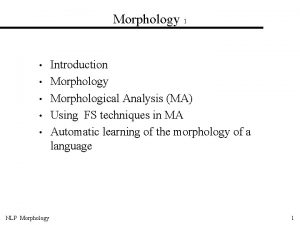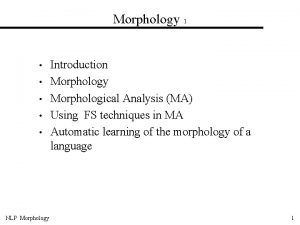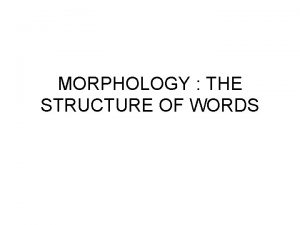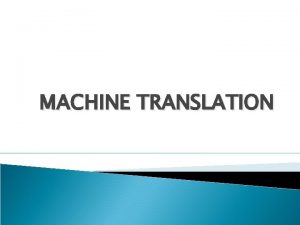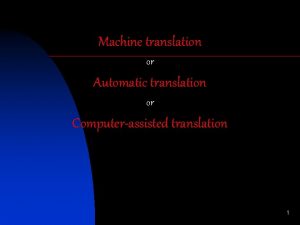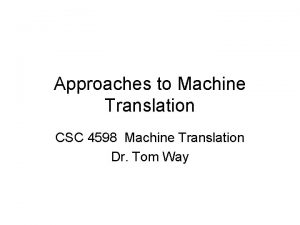Statistical Machine Translation Part VI Dealing with Morphology













































- Slides: 45

Statistical Machine Translation Part VI – Dealing with Morphology for Translating to German Alexander Fraser Institute for Natural Language Processing Universität Stuttgart 2012. 09. 18 Seminar: Statistical MT NSSNLP, University of Kathmandu

Outline § (Other) work on bitext involving morphologically rich languages at Stuttgart § Another word on analyzing German compounds § Morphological generation of German for SMT Collaborators: Fabienne Braune, Aoife Cahill, Fabienne Cap, Nadir Durrani, Richard Farkas, Anita Ramm, Hassan Sajjad, Helmut Schmid, Hinrich Schuetze, Florian Schwarck, Renjing Wang, Marion Weller

Hindi to Urdu SMT using transliteration § Hindi and Urdu are very strongly related languages but written in different scripts § In a small study we determined that over 70% of the tokens in Hindi can be transliterated directly into Urdu § The rest must be (semantically) translated § We designed a new joint model integrating (semantic) translation with transliteration to solve this problem

German subject-object ambiguity § Example: § § German: “Die Maus jagt die Katze” Gloss: The mouse chases the cat SVO meaning: the mouse is the one chasing the cat OVS meaning: the cat is the one chasing the mouse § When does this happen? § Neither subject nor object are marked with unambiguous case marker § In the example, both nouns are feminine, article “die” could be nominative or accusative case § Quite frequent: nouns, proper nouns, pronouns possible § We use a German dependency parser that detects this ambiguity and a projected English parse to resolve it § This allows us to create a disambiguated corpus with high precision

General bitext parsing § We generalized the previous idea to a bitext parsing framework § We use rich measures of syntactic divergence to estimate how surprised we are to see a triple (English_tree, German_tree, alignment) § These are combined together in a log-linear model that can be used to rerank 100 -best lists from a baseline syntactic parser § New experiments on English to German and German to English both show gains, particularly strong for English to German

Improved compound analysis for SMT § Compounds are an important problem for German to English translation and vice versa § The standard approach to solving this is from Koehn and Knight 2003 § Use a simple linguistic search based on limited linguistic knowledge and the frequencies of words which could form the compound § We use a high recall rule-based analyzer of German morphology combined with word frequencies to improve beyond this § Large improvements in METEOR/BLEU beyond Koehn



Outline § Work on bitext involving morphologically rich languages at Stuttgart (transliteration, bitext parsing) § Morphology for German compounds § Morphological generation of German for SMT § Introduction § Basic two-step translation § Translate from English to German stems § Inflect German stems § Surface forms vs. morphological generation § Dealing with agglutination

Tangent: Morphological Reduction of Romanian § Early work on morphologically rich languages was the shared task of Romanian/English word alignment in 2005 § I had the best constrained system in the 2005 shared task on word alignment § I truncated all English and Romanian words to the first 4 characters and then ran GIZA++ and heuristic symmetrization § This was very effective – almost as good as best unconstrained system which used all sorts of linguistic information (Tufis et al)

Tangent: Morphological Reduction of Romanian § Early work on morphologically rich languages was the shared task of Romanian/English word alignment in 2005 § I had the best constrained system in the 2005 shared task on word alignment § I truncated all English and Romanian words to the first 4 characters and then ran GIZA++ and heuristic symmetrization § This was very effective – almost as good as best unconstrained system which used all sorts of linguistic information (Tufis et al) § This alienated people interested in both modeling and (nonsimplistic) linguistic features § I redeemed myself with the (alignment) modeling folks later § Hopfully this talk makes linguistic features people happy

Morphological Generation of German - Introduction § For many translation directions SMT systems are competitive with previous generation systems § German to English is such a pair § The shared task of ACL 2009 workshop on MT shows this § Carefully controlled constrained systems are equal in performance to the best rule-based systems § Google Translate may well be even better, but we don’t know § Data not controlled (language model most likely contains data too similar to test data) § English to German is not such a pair § Rule-based systems produce fluent output that is currently superior to SMT output

Stuttgart WMT 2009 systems § German to English system § Aggressive morphological reduction (compound splitting & stemming) § Deterministic clause reordering using Bit. Par syntactic parser § Worked well (best constraint system) § English to German system § Two independent translation steps § Translation from English to morphologically simplified German § Translation from morphologically simplified German to fully inflected German § Did not work well (worst constraint system) § Better modeling is necessary. . .

Morphological reduction of German § Morphological reduction driven by sub-word frequencies § Simultaneously reduce compounds and stem § Compound reduction used Koehn and Knight 2003 § But it was different: stemming is aggressive; ambiguous suffixes were stripped (motivated by sparsity of news data) § English to German system tried to invert this process § Generate inflected forms (using a second SMT system that translated from reduced representation to normal words using only lemmas and split compounds) § This is too hard!

Morphological generation for German § Goal: fluent output for translation to German § Problem: German is morphologically rich and English is morphologically poor § Many features of German can not be determined easily from English § We will focus on 4 features which are primarily aimed at improving NP and PP translation § These features are: Gender, Case, Number, Definiteness

Inflection Features § Gender, Case, Number, Definiteness § Diverse group of features § Number of the noun and Definiteness of the article are (often easily? ) determined given the English source and the word alignment § Gender of the noun is innate § Often a grammatical gender (for example: inanimate objects in German have genders that are often hard to determine, unlike many Spanish or French nouns) § Case is difficult, for instance, often a function of the slot in the subcategorization frame of the verb § There is agreement in all of these features in a particular NP § For instance the gender of an article is determined by the head noun § Definiteness of adjectives is determined by choice of indefinite or definite article § Etc. . .

Overview of translation process § In terms of translation, we can have a large number of surface forms § English “blue” -> blau, blauer, blaues, blauen § We will try to predict which form is correct § Our system will be able to generate forms which were not seen in the training data § We will follow a two-step process: 1. Translate to “blau” (stem) 2. Predict features (e. g. , Nominative, Feminine, Singular, Definite) to generate the correct form “blaue” 3. I will compare this with directly predicting “blaue” (e. g. the work presented by Ondrej)

Pros/Cons of 2 step process § Pros § Morphological reduction for translation step – better learning from limited parallel data § Some inflection is not really a function of English – e. g. , grammatical gender. Can predict this using only the German sequence of stems § Inflectional features can be treated as something like a (POS) tagging problem § Can build tagging system on clean German text with relevant features removed § Test it by trying to predict original forms § We are solving two easier sub-problems!

Pros/Cons of 2 step process § Conditionality of generation – translate to stems, then predict inflection based on stems § No influence of final word forms on stems § This is particularly a problem for Case (Case would be difficult anyway, but lexical clues would help) § Using features like Case, Definiteness, etc. , could be viewed as solving a more difficult problem then necessary § We may be modeling definiteness even when it doesn’t matter to generation, etc

Syntactic processing § Preprocess data: § Parse all German data (German side of parallel corpus and German language modeling data) with Bit. Par, extract morphological features § Lookup surface forms in SMOR § Resolve conflicts between parse and SMOR § Output “stems” (+markup, this will be discussed later) for stem-based translation system § We also slightly regularize the morphology of English to be more similar to German § We use an English morphological analyzer and a parser to try to disambiguate singular/plural/possessive/us (as in Let‘s) § a/an is mapped to indef_determiner § We would do more here if translating, say, Arabic to German

Translating stems § Build standard phrase-based SMT system § Word alignment, phrase-based model estimation, LM estimation § Run minimum error rate training (MERT) § Currently optimizing BLEU on stems (not inflected)

Stem markup § We are going to use a simple model at first for „propagating“ inflection § So we will make some of the difficult decisions in the stem translation step § The best German stem markup so far: § § § Nouns are marked with gender and number Pronouns are nominal or not_nominal Prepositions are annotated with the case they mark Articles are only marked definite or indefinite Verbs are fully inflected Other words (e. g. , adjectives) are lemmatized

Comparing different stem+markup representations § BLEU score from MERT on dev (this is abusing BLEU!!) § Baseline: 13. 49 § WMT 2009: 15. 80 § Based on Koehn and Knight. Aggressive stemming, reduced compounds. No markup. § Initial: 15. 54 § Based on SMOR. Nouns marked with gender and number; coarse POS tag in factored model. No compound handling (will discuss a special case later) § “version 1 a”: 15. 21 § Same, plus prepositions are marked with case (very useful for ambiguous prepositions)

Review – first step § Translate to stems § But need markup to not lose information § This is true of pivot translation as well § In the rest of the talk I will talk about how to predict the inflection given the stemmed markup § But first let me talk about previous work. . .

Previous work § The two-step translation approach was first tried by Kristina Toutanova‘s group at MSR (ACL 2008, other papers) § They viewed generating an Arabic token as a two-step problem § Translate to a sequence of „stems“ (meaning the lemma in Buckwalter) § Predict the surface form of each stem (meaning a space-separated token) § We are interested in two weaknesses of this work 1. They try to directly predict surface forms, by looking at the features of the surface form § § I will show some evidence that directly predicting surface forms might not be a good idea and argue for a formal morphological generation step This argument applies to Ondrej‘s work as well (I think) 2. Also, Arabic is agglutinative! Thinking of the token meaning and-hisbrother as an inflection of brother is problematic (think about what the English correspondence looks like!)

Inflection Prediction

Solving the prediction problem § We can use a simple joint sequence model for this (4 -gram, smoothed with Kneser-Ney) § This models P(stems, coarse-POS, inflection) § Stems and coarse-POS are always observed § As you saw in the example, some inflection is also observed in the markup § Predict 4 features (jointly) § We get over 90% of word forms right when doing monolingual prediction (on clean text) § This works quite well for Gender, Number and Definiteness § Does not always work well for Case § Helps SMT quality (results later)

Surface forms vs morphological generation § The direct prediction of surface forms is limited to those forms observed in the training data, which is a significant limitation § However, it is reasonable to expect that the use of features (and morphological generation) could also be problematic § Requires the use of morphologically-aware syntactic parsers to annotate the training data with such features § Additionally depends on the coverage of morphological analysis and generation § Our research shows that prediction of grammatical features followed by morphological generation (given the coverage of SMOR and the disambiguation of Bit. Par) is more effective § This is a striking result, because in particular we can expect further gains as syntactic parsing accuracy increases!

1 LM to 4 CRFs § In predicting the inflection we would like to use arbitrary features § One way to allow the use of this is to switch from our simple HMM/LM-like model to a linear-chain CRF § However, CRFs are not tractable to train using the crossproduct of grammatical feature values (e. g. , Singular. Nominal. Plural. Definite) § Using Wapiti (ACL 2010) – Chris says we should be using CDEC. . . § Fortunately, we can show that, given the markup, we can predict the 4 grammatical features independently! § Then we can scale to training four independent CRFs

Linear-chain CRF features • We use up to 6 grams for all features except tag (where we use 8 grams) • The only transition feature used is the label bigram • We use L 1 regularization to obtain a sparse model

English features § SMT is basically a target language generation problem § It seems to be most important to model fluency in German (particularly given the markup on the stems) § However, we can get additional gain from prediction from the English, it is easy to add machine learning features to the CRF framework § As a first stab at features for predicting a grammatical feature on a German word, we use: § POS tag of aligned English word § Label of highest NP in chain of NPs containing the aligned word § Label of the parent of that NP § Labels: Charniak/Johnson parser then the Seeker/Kuhn function labeler

Dealing with agglutination § As I mentioned previously, one problem with Toutanova‘s work is treating agglutination as if it is inflection § It is intuitive to instead segment to deal with agglutination § We are currently doing this for a common portmanteau in German: § Preposition + Article § E. g. , „zum“ -> this is the preposition „zu“ and the definite article „dem“ § This means we have to work with a segmented representation (e. g. , zu+Dative, definite_article in the stemmed markup) for training and inflection prediction § Then synthesize: creation of portmanteaus dependis on the inflection decision § Recently, we got this to work for German compounds as well § We translate to compound head words and compound non-head words, then subsequently combine them. Finally we inflect them.

Evaluation § WMT 2009 English to German news task § All parallel training data (about 1. 5 M parallel sentences, mostly Europarl) § Standard Dev and Test sets § Two limitations of the experiments here: § We were not able to parse the monolingual data, so we are not using it (except in one experiment. . . ) § The inflection prediction system that predicts grammatical features does not currently have access to an inflected word form LM § We have recently overcome these, see our EACL 2012 paper

System BLEU (end-to-end, case sensitive) Baseline 12. 62 1 LM predicting surface forms, no portmanteau handling 12. 31 1 LM predicting surface forms 12. 72 (11 M sentences inflection prediction training), no portmanteau handling 1 LM predicting surface forms 12. 80 1 LM predicting grammatical features 13. 29 4 LMs, each predicting one grammatical feature 13. 19 4 CRFs, German features only 13. 39 4 CRFs, German and English features 13. 58

Newest developments § We now have a rule-based preprocessing setup for English to German translation § See our EACL 2012 paper § This does reordering of English clauses by analyzing what the translated German clause type will be § We are currently working on combining inflection, compounding, verbal reordering and verbal morphology prediction

Summary of work on translating to German § Two-step translation (with good stem markup) is effective § Predicting morphological features and generating is superior to surface form prediction § This depends on quality of SMOR (morph analysis/generation) and Bit. Par (used for morphological disambiguation here) § Performance will continue to improve as syntactic parsing improves § Linear-chain CRFs good for predicting grammatical features § However, tractability is a problem § You can get (small gains) with very simple English features § More feature engineering work is in progress

Conclusion § Lecture 1 covered background, parallel corpora, sentence alignment, evaluation and introduced modeling § Lecture 2 was on word alignment using both exact and approximate EM § Lecture 3 was on phrase-based modeling and decoding § Lecture 4 was on log-linear models and MERT § Lecture 5 briefly touched on new research areas in word alignment, morphology and syntax § Lecture 6 presented work on translation to German which is relevant to morphologically rich languages in general

Thank you!


General bitext parsing § Many advances in syntactic parsing come from better modeling § But the overall bottleneck is the size of the treebank § Our research asks a different question: § Where can we (cheaply) obtain additional information, which helps to supplement the treebank? § A new information source for resolving ambiguity is a translation § The human translator understands the sentence and disambiguates for us!

Parse reranking of bitext § Goal: use English parsing to improve German parsing § Parse German sentence, obtain list of 100 best parse candidates § Parse English sentence, obtain single best parse § Determine the correspondence of German to English words using a word alignment § Calculate syntactic divergence of each German parse candidate and the projection of the English parse § Choose probable German parse candidate with low syntactic divergence

Rich bitext projection features § We initially worked on this problem in the German to English direction § Defined 36 features by looking at common English parsing errors § Later we added three additional features for the English to German direction § § No monolingual features, except baseline parser probability General features § Is there a probable label correspondence between German and the hypothesized English parse? § How expected is the size of each constituent in the hypothesized parse given the translation? § Specific features § Are coordinations realized identically? § Is the NP structure the same? § § Mix of probabilistic and heuristic features This approach is effective, results using English to rerank German are strong

New bitext parsing results (not in EACL 2009 paper) § Reranking German parses § This is an easier task than reranking English parses § The parser we are trying to improve is weaker (German is hard to parse, Europarl and SMULTRON are out of domain) § 1. 64% F 1 improvement currently, we think this can be further improved § In the other direction (reranking English parses using a single German parse), we improve by 0. 3% F 1 on the Brown reranking parser § Harder task - German parser is out of domain for translation of the Penn treebank, German is hard to parse. English parser is in domain


SMOR with word frequency results § Improvement of 1. 04 BLEU/2. 12 Meteor over no processing § Statistically significantly better in BLEU than no processing § Statistically significantly better in Meteor than no processing, and also than Koehn and Knight § This is an important result as SMOR will be used (together with the Bit. Par parser) for morphological generation of German
 8 inflectional morphemes
8 inflectional morphemes Examples of communicative translation
Examples of communicative translation Number translation using voice translation profiles
Number translation using voice translation profiles Linear function transformations
Linear function transformations 10 noun phrases
10 noun phrases Interactive machine translation
Interactive machine translation Lms machine translation
Lms machine translation Visualizing and understanding neural machine translation
Visualizing and understanding neural machine translation Machine translation
Machine translation Machine translation
Machine translation Machine translation
Machine translation Machine translation
Machine translation Meteor vs bleu
Meteor vs bleu Lms machine translation
Lms machine translation Dot translation
Dot translation John hutchins machine translation
John hutchins machine translation Machine translation presentation
Machine translation presentation Thorsten brants
Thorsten brants Assimilation linguistics
Assimilation linguistics Abiotic factors
Abiotic factors Section 2 dealing with other nations
Section 2 dealing with other nations Call center stress
Call center stress Dealing with competition marketing management
Dealing with competition marketing management It is a genre of speculative fiction dealing
It is a genre of speculative fiction dealing Chapter 5 lesson 1 dealing with anxiety and depression
Chapter 5 lesson 1 dealing with anxiety and depression Chapter 5 lesson 1 dealing with anxiety and depression
Chapter 5 lesson 1 dealing with anxiety and depression Dealing with competition marketing management
Dealing with competition marketing management Unit 1 dealing with incoming calls
Unit 1 dealing with incoming calls Dealing with anger in the bible
Dealing with anger in the bible Dealing successfully with difficult changes in your life
Dealing successfully with difficult changes in your life Areas of lexicology
Areas of lexicology A play dealing with unhappy ending
A play dealing with unhappy ending Dealing with unstructured data
Dealing with unstructured data Reuters electronic trading
Reuters electronic trading Dealing with unstructured data
Dealing with unstructured data The branch of zoology dealing with insects
The branch of zoology dealing with insects The branch of zoology dealing with insects
The branch of zoology dealing with insects Dealing with challenging patients
Dealing with challenging patients Dealing successfully with difficult changes
Dealing successfully with difficult changes Dealing with unstructured data
Dealing with unstructured data Insider dealing
Insider dealing Resolve complaint
Resolve complaint 3p fair dealing
3p fair dealing External synoynm
External synoynm Dealing with objections
Dealing with objections Smita had been working as an assistant manager
Smita had been working as an assistant manager
